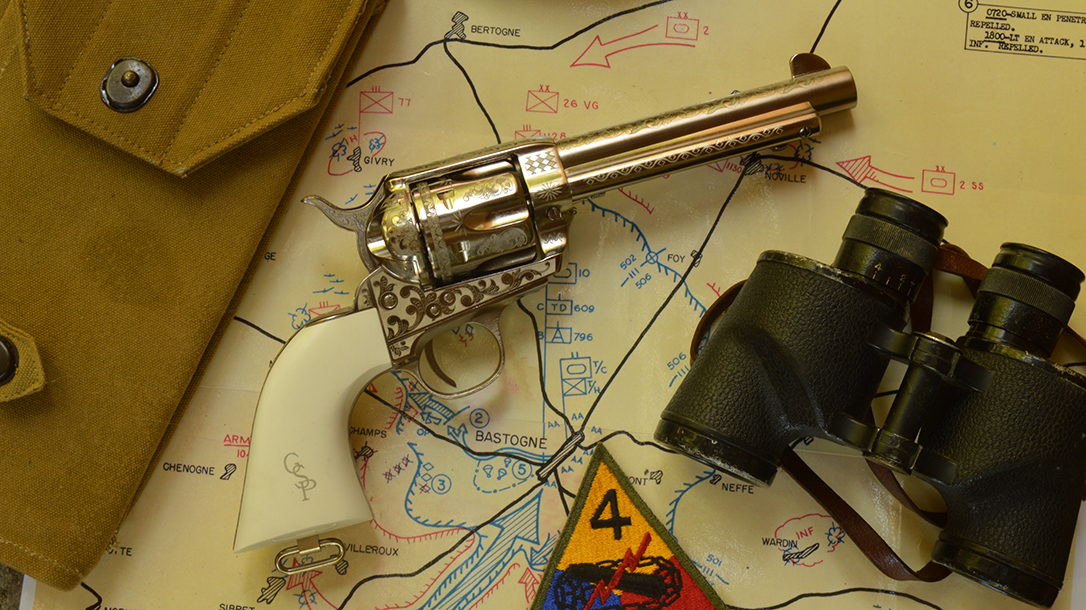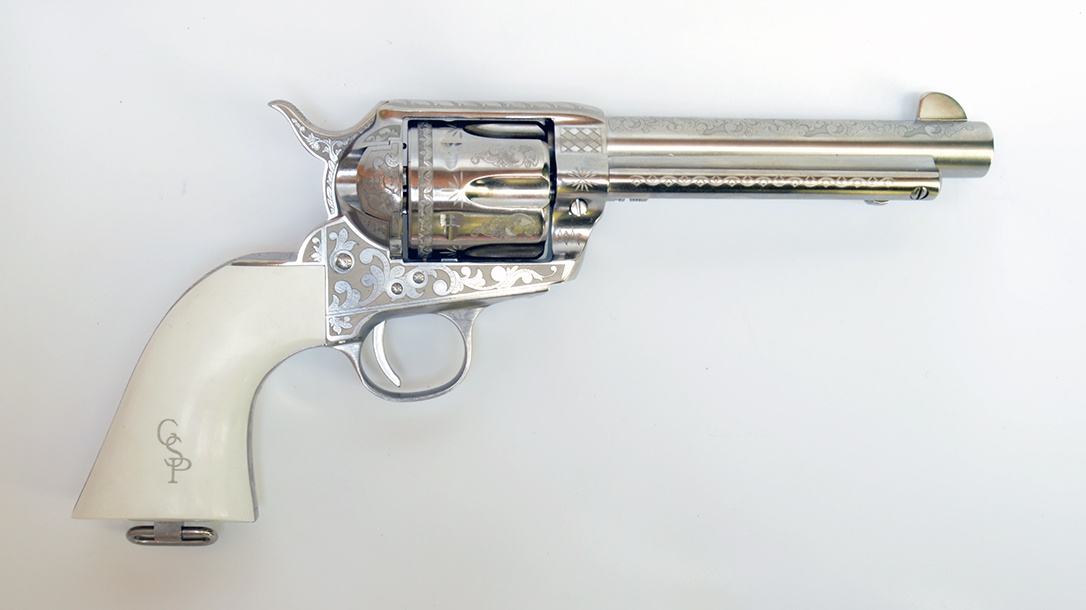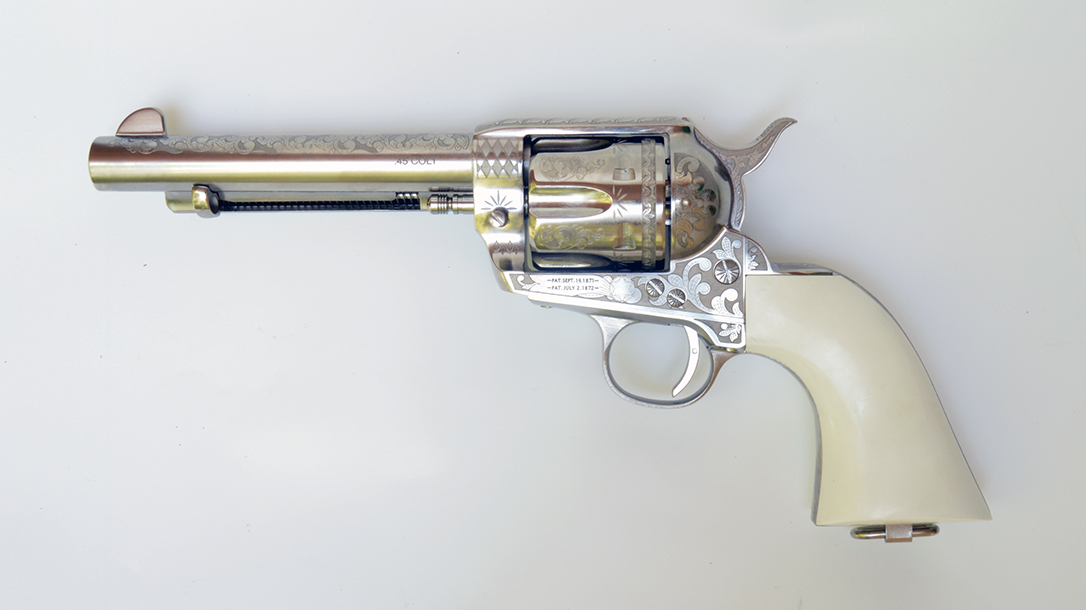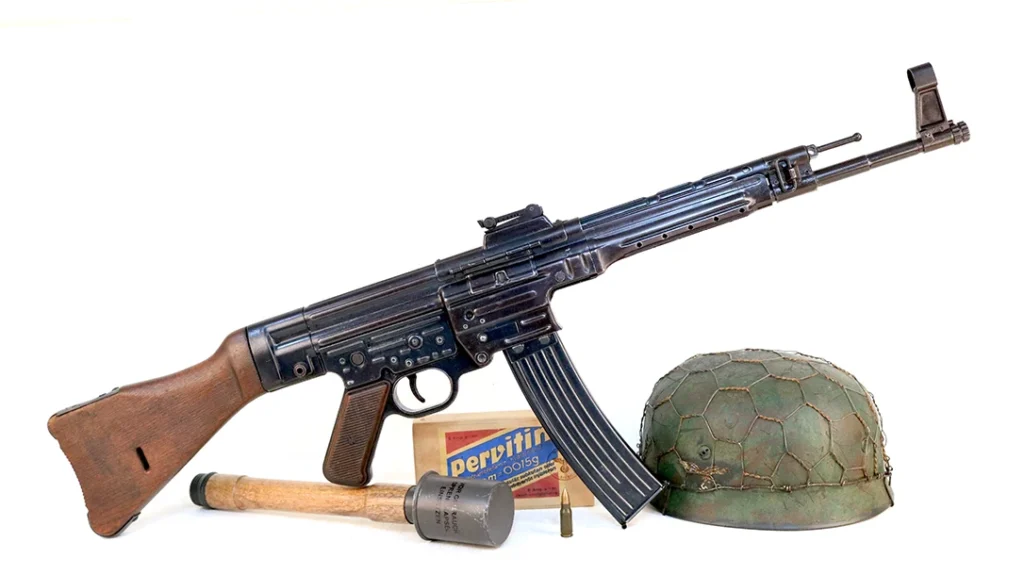Without question, the most iconic and readily identifiable handgun in the world associated with a single person is the engraved, ivory-gripped Colt Model 1873 Single Action Army owned by General George S. Patton. This is due entirely to the character and charisma of the man himself. More than any other American military leader of the 20th century, Patton masterfully cultivated his persona on and off the battlefield, with few notable military or media blunders to tarnish his image. Patton’s Colt was actually a carefully calculated part of his image. A number of firms have made non-firing replicas of this pistol over the years, but Cimarron has finally produced a Patton-inspired Colt that you can actually shoot.
The original revolver still exists and is currently on display at the Patton Museum of Leadership at Fort Knox, Kentucky. I was responsible for its care and exhibition from 2000 to 2007, when I was director of the heavily tank-oriented museum, which preceded the present one, the Patton Museum of Cavalry & Armor. And Patton’s Colt captured the imagination of visitors more than any other artifact in the collection. To put that statement in perspective, I had some really spectacular artifacts like the only surviving Mark V heavy tank from World War I and a massive Tiger II tank captured during the Battle of the Bulge. I drew my conclusions about the revolver after years of studying Patton’s letters and all the photographs and film footage I could find.
Advertisement — Continue Reading Below
Why The Colt?
When he was 30 years old, Second Lieutenant Patton purchased his Colt in 1916 while serving as an aide to Brigadier General John “Black Jack” Pershing during the Punitive Expedition against Mexican-revolutionary-turned-outlaw Pancho Villa. This wasn’t much of a war, but an ambitious career soldier needs combat experience to gain rank, and it was the only place the U.S. Army was fighting.
Patton was what we would call a “gun guy” today. He enjoyed shooting and collecting guns of all types, and was exceptionally well informed about military science and related technology. So why did Patton select a personal sidearm that was totally obsolete for his first combat tour? Above all, the answer explains the man.
In 1916, the Model 1873’s legacy as a combat handgun was very much a part of living memory. It was still commonly carried and used in the West, even by lawmen, including Texas Rangers. It had a solid reputation for good balance, reliability and stopping power, and many were in circulation. Some refurbished models were issued to U.S. troops as late as the Philippine Insurrection and the subsequent postwar battles with natives of the southern islands that continued into 1913.
Advertisement — Continue Reading Below
Patton’s Romanticism
Still, nobody in the Army was really upset when the Model 1911 autoloader finally put the big old six-shooter out to pasture. Patton would point out that the loss of the 1911’s magazine would render it a single-shot pistol, but he was well aware that the autoloader was a superior fighting pistol and much better suited to his branch of choice, the cavalry, still on horseback at the time.
I believe the six-shooter’s appeal to Patton had very little to do with its long military history. Otherwise, he would have just bought himself a military-style, 7½-inch-barreled Colt with a blued finish and plain wood grips. Patton needed more romanticism than the Colt’s cavalry lineage could provide. That’s why he chose a heavily engraved, nickel-plated, 4¾-inch-barreled model with ivory grips. This was a very expensive gun, costing $50 at a time when the standard model ran about $12.
To understand why Patton chose the ornate Colt single-action revolver, we need to look to what he most wanted to be. More than anything else, he wanted to be a hero. He chose a pistol suitable for the pulp-magazine Western heroes who loomed large in his—and every other American’s—boyhood. Those brave cowboys and lawmen, both fictional and real, remained tremendously popular in the 1920s, 1930s and 1940s on radio and in motion pictures as new generations of men came of age. There’s no question in my mind that the Lone Ranger’s nickel-plated and white-gripped six-shooters helped Patton’s Colt maintain its cultural gravitas. It’s no surprise that he began carrying it again at the start of World War II.
Advertisement — Continue Reading Below
In Combat
Something not commonly known about the man who earned himself the nickname “Old Blood and Guts” in WWII is that he only fired a weapon at a hostile combatant one time in his career. The date was May 14, 1916. The weapon was his Colt, the San Maguelito Ranch in Mexico his battlefield, and three Villistas his enemies.
Patton’s first combat was no accident. Unsatisfied with his logistical assignments as one of Pershing’s aides-de-camp, he was looking for an opportunity. He conducted his boring supply and courier duties as reconnaissance missions, and this eventually paid off. He learned that Villista Colonel Julio Cárdenas, Pancho Villa’s second in command, sometimes visited his wife secretly at the San Maguelito Ranch. Patton was leading 10 soldiers and two civilian guides on a routine foraging trip in three Dodge touring cars and decided to check the walled, fortress-like ranch compound.
Convinced that Cárdenas was there, Patton ordered his group to drive at high speed toward the ranch and deploy. Three mounted men attempted to race out of the compound gate and drew weapons. Patton happened to be standing right in their path. Everyone opened fire. Patton hit the lead rider in the arm, and that man fell from his horse and retreated inside the ranch. Another rider tried to charge past. Patton later said he recalled the advice of an old lawman, that the fastest way to stop a mounted man is to shoot his horse. That is exactly what he did. Man and beast hit the ground. When the man rose, he was shot by Patton and several of his men.
Advertisement — Continue Reading Below
Patton’s Colt Gets Notched
When the fight was over, nobody in Patton’s group had a scratch, but all three Villistas were dead, suffering multiple gunshots wounds. Patton put two notches in his Colt’s left-side grip panel anyway. The first man Patton shot was actually Julio Cárdenas. The bullet broke his arm, but he still fought to the death. Patton wrote that Cárdenas feigned surrender to trick a soldier into getting close, then raised his pistol to ambush him. The trick, if it was one, didn’t work. The soldier shot Cárdenas dead with his rifle. Patton claimed a lot of souvenirs, including Cárdenas’s sword, rifle, pistol, saddle, lariat and spurs.
He then had the three dead men strapped onto their Dodge cars like freshly killed game, and returned triumphantly to camp. Pershing was impressed. Patton had showed initiative and bravery in the engagement. I believe this was actually the first mechanized cavalry attack in U.S. Army history. Additionally, It made Patton a national celebrity in the newspapers and earned him a promotion to first lieutenant.
Instant Classic
Cimarron’s handsome tribute to General George S. Patton is based on Pietta’s excellent Peacemaker reproduction. The Pietta was the perfect choice because its triggerguard shape (rounder rather than flat along the bottom) exactly matches Patton’s 1916 vintage pistol. However, this revolver is not intended to be an exact reproduction. Further, it is meant to capture the key features that everyone recognizes in the most famous revolver in the world. It has white grips with the entwined initials “GSP.” It is nickel-plated. It’s engraved. It has a lanyard ring.
Advertisement — Continue Reading Below
When it’s riding high on the hip in a right-handed, forward-canted 1930s S.D. Myers holster, it absolutely looks the part. El Paso Saddlery (epssaddlery.com) makes a high-quality replica of the leather pistol belt ($90), 12-round ammo slide ($99) and holster ($165). Patton famously carried his single-action Colt during the entirety of WWII.
The most noticeable different between the original and Cimarron’s take is the barrel. The replica has a 5½-inch barrel while the original’s was 4¾ inches long. The grips are, of course, faux ivory, and they lack the Colt medallions, right-hand grip screw and high-relief eagle carving on the left grip. The omission of the carving is a practical consideration when you get down to it. Not everyone likes the feel of raised relief art on their grips. I’m one of them. Also, pistol features a fixed lanyard; this keeps the base from spinning.
Engraving & Appointments
The laser engraving is simplified but clearly inspired by the original. Also, the original gun was deeply, heavily and intricately engraved at the factory and included lots of borders that are omitted on the replica. There’s only so much that can be done with laser engraving. Fortunately, Pietta knows how to get the most out of it, and it looks very good. Oddly, Cimarron also engraved the hammer, which was one part that Patton did not.
Advertisement — Continue Reading Below
The degree of shine on the nickel plate of the modern gun isn’t quite as high as the original because of the underlying polish on the metal before plating. Keep in mind, though, that this is not a custom-order pistol. Patton paid $50 for his in 1916. Further, that’s almost $1,200 today. For those who want a great-shooting, Patton-inspired Colt, Cimarron and Pietta have done the best job possible outside of a custom shop.
Range Time
If you’ve never shot a Pietta-made Colt replica, you’ll be surprised and pleased with the quality of the action. In April of 2017, I visited with Alessandro Pietta at the factory in Brescia, Italy. A very active Single Action Shooting Society (SASS) member himself, Alessandro told me of his efforts to make their production 1873 replicas with the most practical and economical refinements competitors want, so their pistols are match ready right out of the box.
Advertisement — Continue Reading Below
This was evident in the Patton revolver, which is a standard production gun internally. It exhibits the feels of an action job, cocking smoothly and easily. The trigger pull breaks crisp and light at around 3 pounds, perfect for target work, but you better maintain proper trigger discipline lest you discharge a round before you’re ready. It seemed as though all I had to do was think about it, and the trigger would break. Also, accurate shooting requires a great trigger, and the Pietta has it.
I tested the pistol at 25 yards from a bench using a sandbag rest, and my average five-shot group size for all of the test ammo was 3.01 inches. Federal’s American Eagle 225-grain JSPs were the most accurate, averaging 2.79 inches. It was also the fastest at 860 fps. Also, Winchester’s 250-grain Cowboy Action load came in second with a group average of 3.01 inches.
Final Thoughts
On the downside, shiny nickel finishes are detrimental to good sight alignment. Also, the pistol features a rounded front sight, which makes it a more difficult to level off in the square notch rear sight. Additionally, trying to nestle a shiny, rounded front sight consistently in a shiny notch caused me to string my shots a bit vertically. I would have shot better if I’d remembered to blacken the backside of the front sight with a marker. On the plus side, at least the sights are wider than the original’s.
Advertisement — Continue Reading Below
This gun gets a lot of attention at the range, even though the man who made it famous died in 1945. Additionally, Patton deliberately made an effort to maintain the Colt as a permanent element of his warrior image. Also, in 1945, he took the time to have a formal portrait painted by the Polish artist Boleslaw Jan Czedekowski. Finally, it hangs today in the National Portrait Gallery in Washington, D.C., and you’ll notice his single action hanging from his hip.
Cimarron Patton Laser-Engraved Frontier Specifications
- Caliber: .45 Colt
- Barrel: 5½ inches
- OA Length: 11 inches
- Weight: 37 ounces (empty)
- Grips: Poly ivory
- Sights: Fixed
- Action: SA
- Finish: Nickel
- Capacity: 6
- MSRP: $766
Cimarron Patton Laser-Engraved Frontier Performance
Load: Accuracy
- Federal American Eagle 225 JSP: 2.16
- Hornady 225 LeveRevolution FTX: 2.50
- Winchester 250 Cowboy Action: 2.88
Bullet weight measured in grains, velocity in fps by chronograph and accuracy in inches for best five-shot groups at 25 yards.
This article is from the Spring 2019 issue of Guns of the Old West magazine. Grab your copy at OutdoorGroupStore.com. For digital editions, visit Amazon.

























